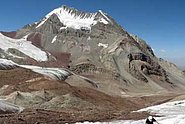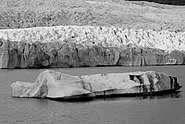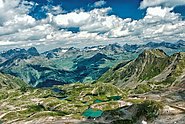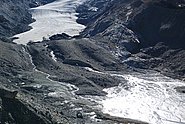Probable scenarios of future changes in Elbrus glaciers and phenomena associated with them, such as the formation of glacial lakes and residual ice masses buried under the debris cover, are considered. The Shared Socioeconomic Pathway (SSP) scenarios (SSP1–1.9, SSP1–2.6, SSP2–4.5, SSP3–7.0, and SSP5–8.5) were used for of future climate forcing. Glacier dynamics was simulated using the GloGEMflow model, which was improved by including a module of transforming debris cover. According to the prognostic calculations of the surface mass balance of the glaciers, the loss of ice mass on Elbrus will accelerate until the end of the 2030s, reaching approximately –1.1 ± 0.3 m.w.e. yr–1. The volume of the glacier ice is expected to be reducing almost linearly until about 2040, after which the mass loss rate will slow down. Under the warmest climate change scenarios (SSP5–8.5, SSP3–7.0), almost all of the remaining ice masses in the North Caucasus will be concentrated on Elbrus by the end of the century. At the same time, by 2100, the glaciers of Elbrus themselves will retreat up to 4000 m a.s.l. and higher. In the case of moderate warming (SSP1–1.9, SSP1–2.6), the position of glacier fronts may be stabilized at an altitude of 3600–3700 m. The study concerns also the dynamics of the debris cover, predicting its doubling in area and average thickness of 0.22 m by 2040. Although the effect of the debris cover on the total volume of ice on Elbrus is estimated to be minimal, it can temporarily retard the melting of the frontal parts and areas of dead (residual) ice. According to our estimates, the retreat of the Elbrus glaciers may result in formation of up to 17 new lakes, of which 6 may potentially be temporarily dammed by dead (residual) ice zones (up to 60 m in thickness for Dzhikaugenkioz). It is expected that the largest lake may be formed on the Dzhikaugenkioz plateau; it will be dammed by moraine with ice buried under it in the period from 2035 to 2045 if no sufficiently efficient runoff channels will appear. The approximate time and place of formation of such dead ice masses near the sites of lake formation, depending on the climatic scenario, are shown in the paper, since it is important from the point of view of the risk of outburst floods in the 21st century. Under moderate warming (scenario SSP1–2.6), up to 8 lakes are likely to be formed at the site of retreating Ulluchiran, Dzhikaugenkioz, and Bolshoy Azau glaciers. All of them may appear in the first half of the century, regardless of the climatic scenario. Probable scenarios for changes in the Elbrus glaciers and related phenomena, such as the formation of glacial lakes and areas of dead ice buried under moraine in the future are considered. We estimate that glacier retreat could result in the formation of 8 to 17 new lakes, of which 6 could potentially be temporarily dammed by zones of dead ice up to 60 m in thickness.
Siehe DOISiehe Institutional Repository DORA



